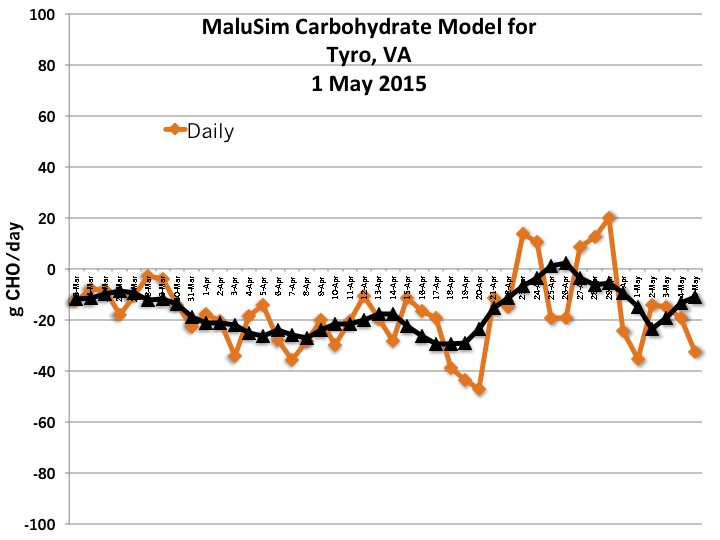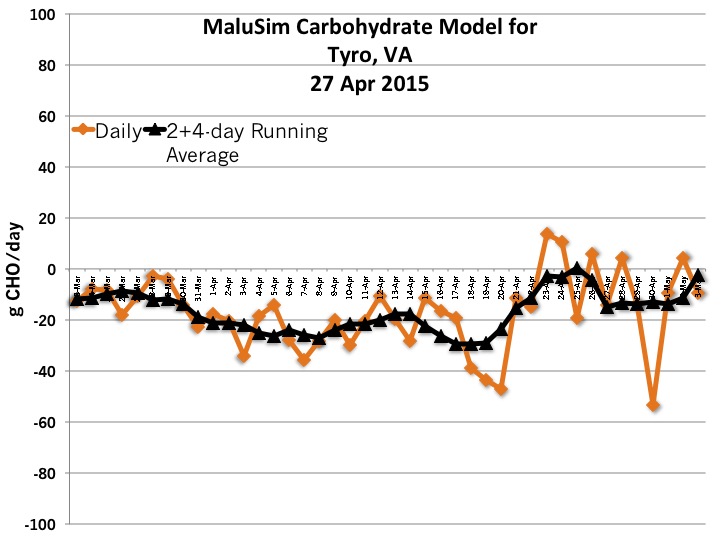On Monday, I ran the MaluSim model for Winchester and a season recap for the Central Virginia region.

For the Winchester area, the carbohydrate status has been in the -20 to 20 g CHO/day range since May 15. This means that thinning sprays made between last Thursday and today are predicted to have an average response. For the next couple of days, the model is showing a significant carbohydrate deficit. This is being caused by the cloudy weather that is predicted, as neither day nor night temperatures are forecast to be very high. Cloud cover remains the hardest variable to forecast. If the next two days are sunnier than forecast, or if the rain showers occur at night, then I would not expect the actual carbohydrate balance to go into such a low deficit. However, if the weather forecasts that I used in the model are accurate, then growers should avoid thinning on Wednesday. Either way, the best predictor of the potency of chemical thinners is the 2 days before, day of, and 3 days after (2+4-day) running average (the black line). As you can see, the running average remains between 0 and 20 g CHO/day, meaning that chemical thinners will have an average response.

For the Central Virginia region, I’ve run a recap of the season using weather station data through Monday, May 19. Growers should compare their thinning results to the carbohydrate status at the time they made their application to see how well the model predicted the potency of thinners this year. From my experience, using the MaluSim model as a forensic tool can really help explain why chemical thinners work so differently from one year to the next. As I repeatedly have said, the most difficult part of using the MaluSim model to make real time decisions is having accurate weather data to use as inputs. As I mention above, cloud cover can really impact the carbohydrate status in the tree, and thus the responsiveness of thinners, but it is the hardest variable to forecast. Additionally, weather can be very local. We experienced this issue with the major differences between Tyro and Piney River weather forecasts. We also saw a lot of variable temperature data, with several days between May 8 and 14 being 5 or more degrees Fahrenheit warmer than forecast.
Even with these issues, I hope that the model is providing useful information that helps you make sound management decisions. If you have any feedback, please don’t hesitate to contact me.
I will continue to run the Winchester model until fruit size is too big to thin with NAA and 6-BA.
Download the full reports:
Central VA MaluSim 5_19_14
Winchester VA MaluSim 5_19_14







 Thinning applications made on Monday through Wednesday of this week will likely see an excessive amount of thinning, especially if fruit was 8-12 mm in diameter. Thinners that were applied on Thursday will likely have a moderate to strong response. Thinners applied Friday (if it stops raining!) through the weekend will have a normal to weak response. If the weather forecast holds, growers should consider slightly increasing rates and using a surfactant for thinning applications made over the weekend. I’ll run another MaluSim model on Monday.
Thinning applications made on Monday through Wednesday of this week will likely see an excessive amount of thinning, especially if fruit was 8-12 mm in diameter. Thinners that were applied on Thursday will likely have a moderate to strong response. Thinners applied Friday (if it stops raining!) through the weekend will have a normal to weak response. If the weather forecast holds, growers should consider slightly increasing rates and using a surfactant for thinning applications made over the weekend. I’ll run another MaluSim model on Monday.



